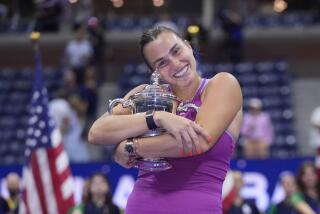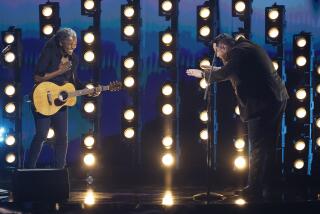For Pete’s Sake, This Is Unusual
NEW YORK — If the curtain can come down on “Cats” one last time after 18 years on Broadway, if the tyrant Bob Knight can finally be deposed at Indiana University, then it shouldn’t be that difficult to accept the end of Pete Sampras’ run as the dominant player in men’s tennis.
Sampras very well could have a few Grand Slam titles left in him. But the days when he enters every non-clay tournament as the favorite, when he could win half his matches on intimidation and the other half on willpower are over.
Part of it is by Sampras’ own doing. After securing his place in history with his record 13th Grand Slam title at Wimbledon this summer, and having already finished atop the rankings for six consecutive years, Sampras is playing with house money. There’s not much more tennis has to offer him.
But in some ways this is out of Pete’s hands. He’s just as helpless as he was on Sunday, when Marat Safin blazed winners past him in the U.S. Open final.
Safin was, as they say in tennis, too good. He faced Sampras on Pete’s home turf and ran him off like a qualifier, rolling to a 6-4, 6-3, 6-3 victory.
“It’s a bit of a humbling feeling to have someone play that well for that long,” Sampras said.
Sampras is usually on the other end of those beatings. And watching the 20-year-old Safin overpower him reminded Sampras of the time he was 19, beating Andre Agassi in the 1990 Open final to win his first Grand Slam championship.
Sampras is 29 now, and the shifting of the tennis world was impossible to ignore at this Open.
The ATP rolled out a promotional campaign with leaflets, posters and CD-ROMs, with the slogan “New Balls, Please,” all geared toward promoting the next wave of stars.
Well, the new balls are in play.
The final weekend turned out to be more a battle of the ages than for the ages. None of these matches will be remembered for classic drama, yet this could go down in history as a turning point for the tour. It was Generation X vs. Generation Y, “Fast Times at Ridgemont High” vs. “Clueless,” with Sampras and 30-year-old Todd Martin squaring off against Lleyton Hewitt, 19, and Safin.
Safin took care of both Martin and Sampras, and Hewitt gave Sampras all he could handle before falling 7-6 (7), 6-4, 7-6 (5) in the second semifinal on Saturday, making it just a little harder for Sampras on Sunday.
“It gets tougher, the older you get, to go back-to-back,” Sampras said. “But I felt fine.”
Experience was the one thing Sampras and Agassi had going for them over these younger, faster, stronger players. Now that’s gone. Safin just showed he has the mental fortitude to come through in a Grand Slam event, and Hewitt is pretty close.
Safin’s game is so smooth that he makes it look easy. He can sit back and blast winners from the baseline. He can even mix in a few drop shots from back there. And his serve comes in at 130 mph.
This kid isn’t going away any time soon, so let’s make sure we pronounce his name correctly.
It’s Mah-RAHT SAH-feen.
And perhaps at the next tournament it will carry some weight.
Safin joked that he had to call the transportation desk three times to get a ride out to Queens for the semifinals.
“What’s your name?”
“Safin.”
“Can you spell it, please?”
“It’s not so difficult to remember this name,” Safin said. “Is not so difficult.”
He may not think so, but that didn’t prevent Sampras from referring to him as “Mareet” in the interview room and “Marit” on the court for the post-match ceremony. And USTA President Judy Levering called him Marat Safan.
At least they got the amount of the winner’s check right, which is more than the suits did during the women’s ceremony. You could see Safin’s brain calculating the exchange rate when the $800,000 prize was announced.
The good-natured Safin wasn’t about to let those little details ruin his fun. In his exuberance, he dropped the trophy twice and dented the lid. And Safin’s managers ordered up a tray of shrimp, lobster, champagne and Stolichnaya vodka, which was wheeled in during Safin’s news conference. (A short while later, in what has to be a first, Safin posed for pictures with a bottle of Stoli parked in the trophy’s bowl.)
The strangest thing about the post-match proceedings was watching Sampras with the runner-up plate. He looked as if he didn’t know quite what to do with it.
Traditionally, when Sampras gets this far you can go ahead and engrave his name on the trophy. He had only lost in two of his previous 15 Grand Slam finals, and none since the ’95 Australian Open.
“It was weird at the ceremony,” Sampras said. “I usually hold up the big trophy.”
Perhaps he should get used to it, even if he isn’t ready to concede right away.
“I don’t want to say ‘Changing of the guard,’ ” Sampras said. “Obviously, it’s a huge win for him. But I’ll be back.”
He will. It just won’t be in the familiar role.
*
J.A. Adande can be reached at his e-mail address: j.a.adande@latimes.com
More to Read
Go beyond the scoreboard
Get the latest on L.A.'s teams in the daily Sports Report newsletter.
You may occasionally receive promotional content from the Los Angeles Times.










